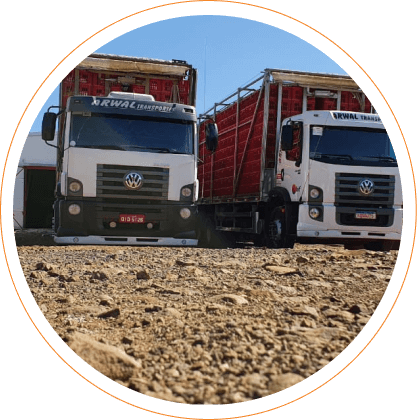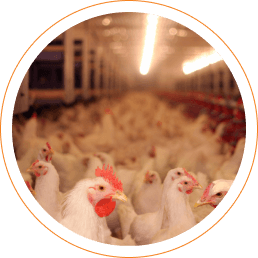Monitoring, Control And Management
Continuous Improvement in Supply Chain Monitoring.
There is continuous monitoring of mortality at all stages of the production chain, as well as improvements in animal weight gain, the number of eliminated animals, farm density (quantity or live weight of animals per square meter in a facility), disease occurrence, average animal transportation time, transportation density, and mortality, and pre-slaughter stunning processes. This is done preventively and with corrective actions when necessary.
When the monitored indicators show any trend of deviation, committees are set up in each production unit to find opportunities for improvement. The committees unite links in the production chain, seek solutions and best practices..
We have developed specific corporate animal welfare instructions for each stage of the chain, where all minimum actions at each stage are described and easily accessible to employees. The score card helps us to act in a preventive and systemic way according to these guidelines.
BRF has a Corporate Live Cargo Transport Committee that monitors the agricultural transport indexes. Transportation time is still a major challenge, given the territorial dimensions of each location (such as Brazil).
To mitigate transportation stress, we have recommendations established in the internal corporate guidelines, which recommend that the maximum time for transporting animals does not exceed 8 hours. The trucks have a predetermined route, trackers for speed control, telemetry and drivers are periodically trained in animal welfare and defensive driving.
| Proportion of animals transported lasting up to 8 hours | |
|---|---|
| Indicator | Overall Total |
| 2022 | |
| Poultry | 98.6% |
| Swine | 99.45% |
| 2023 (1ST HALF) | |
| Poultry | 98.88% |
| Swine | 99.36% |
The entire fleet undergoes periodic inspections to prevent the vehicle from causing any type of injury of the animal. When this situation is detected, the vehicle is sent for maintenance and only returns to the process after verification by the animal welfare officer. The contract time of the vehicles is 10 years, but the average age of the vehicles in 2023 is 4 years.
BRF establishes standards for transport vehicles and live cargo, which are reviewed annually in order to ensure best practices. As part of the company's commitment to safety aspects, we use high technology by installing fatigue sensors to detect signs of driver fatigue and thus provide safety to animals.
We have the Ranking of Transporters that are evaluated by the GIF (Integrated Supplier Management) PROGRAM, so we can measure their adherence to safety, environment and operation management.
We also have a corporate instruction in the event of a claim in the transportation of live cargo. So, drivers know what to do in the event of an accident. In addition, all vehicles have stickers identifying the person in charge of BRF to pass on the first guidelines in case of emergency.
The processes and technologies implemented for transportation contribute to the evolution of results. One of the indicators monitored is Dead on Arrival.
| DEAD ON ARRIVAL | |||||
|---|---|---|---|---|---|
| Chicken | 2019 | 2020 | 2021 | 2022 | 2023 |
| 0,145% | 0,146% | 0,145% | 0,15% | 0,17% | |

The indicators of dead on arrival and transport time have remained stable over the years, despite the slight worsening of the indicator in the last year so far evaluated, due to the company's governance in relation to the subject.
Making animals insensitive to pain before slaughter is central to our commitment to ensuring that the highest standards of animal welfare are met. Therefore we conduct daily internal animal welfare monitoring at each BRF processing plant, which includes a critical checkpoint to ensure proper and effective stunning.
We respect our customers and carry out religious slaughter without prior stunning to slaughter in plants in Brazil to serve the specific market.
According to the mapping carried out in our chain, the percentages of stunning animals are:
The percentage of animals in global operations that undergo pre-slaughter stunning
| Swine | Chicken | Turkey | Eggs | Cattle | |
| Brazil | 100% | 75% | 100% | 100% | 75% |
| Turkiye | N.A | 100% | N.A | Not mapped | Not mapped |
All employees working with live animals receive animal welfare training. Employees working in the stunning area are specifically trained to identify signs of poor stunning and, if necessary, repeat the process for pigs.
Together with the Animal Welfare Officer, they have the authority to stop the line and make the necessary adjustments so that the stunning works with total efficiency. For birds, the quality of stunning is monitored by a trained employee and if poor stunning is detected, adjustments are made to the electrical parameters so that stunning is effective.

